Vincent Dubois, one of the three organiste titulairs at Notre Dame de Paris, released a statement that began “Contrary to rumors that have circulated, the great organ is, a priori, saved. There are a few puddles on the left and right, but nothing dramatic. ”
AGOYO News
Calling All Advanced Organists Entering a High School Grade This Fall…
Do you know any advanced organists entering a high school grade this fall? Please encourage them to apply today for the 2019 Pipe Organ Encounter (Advanced) in Houston! Sponsored by the Houston (Tex.) Chapter of the American Guild of Organists, the POEA will feature world-class organs, internationally recognized faculty from around the nation, and of course many unique Texas traditions!
On Monday, June 24, we’ll take a behind-the-scenes tour of NASA’s Space Center Houston – this isn’t the regular public tour, folks! Tuesday afternoon will feature a class on music marketing and technology led by S. Andrew Lloyd (University of Texas at San Antonio) followed by a hymn playing and liturgical improvisation class and silent film performed by Jason Roberts (Westminster Choir College). On Wednesday, after learning about organ building/maintenance from Jason Alden (Alden Organ Service) and continuo playing from Matthew Dirst (University of Houston), you’ll have an opportunity to visit the Houston Zoo and its incredible new African Forest exhibit. And no trip to Texas would be complete without enjoying incredible TexMex and Texas BBQ – don’t worry, we’ve got that covered!
All participants will have the opportunity to practice multiple hours per day, work with two POEA faculty members during the week, participate in a small group masterclass, and perform in the final student recitals on the monumental Fisk-Rosales organ at Rice University. Workshops on career development, the liturgical year, and practical repertoire will also be offered. The final student recitals will be professionally videorecorded and made available to all participants!
FACULTY
Jeong-Suk Bae (Univeristy of St. Thomas)
Ken Cowan (Rice University)
Isabelle Demers (Baylor University)
Stefan Engels (Southern Methodist University)
Rhonda Furr (Houston Baptist University)
Anne Laver (Syracuse University)
Daryl Robinson (University of Houston)
Catherine Rodland (St. Olaf College)
GUEST ARTISTS
Jason Alden (Alden Organ Service)
Matthew Dirst (University of Houston)
S. Andrew Lloyd (University of Texas at San Antonio)
Jason Roberts (Westminster Choir College)
Click here to start the application process online.
Contact POEA Director Daryl Robinson with any questions about the application/audition process, scholarships, or other topics.
Daryl Robinson, Director
Pipe Organ Encounter Advanced (POEA) is for participants in grades 9-12 who have achieved a high level in organ study. Prospective attendees must submit an audition recording to apply. A POEA provides daily lessons and a unique opportunity for participants to meet and interact with peers who have similar interests.
Marilyn Mason: 1925-2019
The organ world has grown smaller with the passing of legendary organist, scholar, teacher, and performer, Marilyn Mason, yesterday in Florida. Dr. Mason was the foremost champion for commissioning new music for the organ and the benefactor of the AGO/Marilyn Mason Award in Organ Composition.
Marilyn Mason’s performing career took her around the globe. She was the first female organist ever to perform at Westminster Abbey, the first female organist to play in Latin America, and the first American organist to perform in Egypt. She was named the International Performer of the Year by the New York City Chapter of the American Guild of Organists in 1988 and was honored at the AGO Endowment Fund Gala in 2009.
She was the subject of an AGO Master Series teaching video produced in 2009. It can be viewed on YouTube.com.
Marilyn Mason is perhaps best known for having been the longest tenured faculty member at the University of Michigan (Ann Arbor). She retired in 2014 after having taught for 67 years. During those years, she trained three generations of prize-winning students for successful careers as church organists, performing artists, and teachers.
We will never forget you, Marilyn.
F. Anthony Thurman
Director of Development and Communications
Read Marilyn Mason’s obituary.
Read the New York Times obituary
April 2019 TAO Feature Article
 Central United Methodist Church
Central United Methodist Church
Fayetteville, Arkansas
Buzard Pipe Organ Builders
Champaign, Illinois
by John-Paul Buzard
View an enlarged cover
View the Stop List
It has been a privilege and honor to have designed and built this new organ for Central United Methodist Church in Fayetteville, Arkansas. Particularly humbling was that music director Frode Gundersen and organist Scott Montgomery selected our firm after lengthy auditioning tours to instruments made by many other fine organbuilders. I believe it was a combination of outstanding constructional quality, tonal sophistication, honorable business practices, and personal “chemistry” that won the day for us.
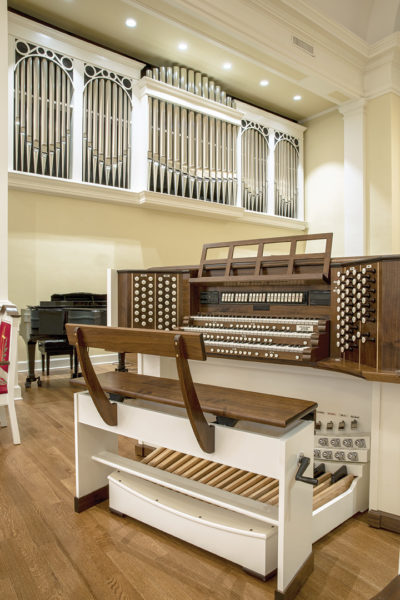 In addition to selecting an organbuilder, Frode and Scott were charged by the church to renovate and improve the acoustics of the sanctuary and to design and construct a comprehensive new two-story music suite, which wraps itself around the chancel end of the church building. The mantle for these tremendous responsibilities was placed on them in addition to their regular tasks of creating music for inspirational worship before, during, and after construction.
In addition to selecting an organbuilder, Frode and Scott were charged by the church to renovate and improve the acoustics of the sanctuary and to design and construct a comprehensive new two-story music suite, which wraps itself around the chancel end of the church building. The mantle for these tremendous responsibilities was placed on them in addition to their regular tasks of creating music for inspirational worship before, during, and after construction.
The results of their labors are a visually and acoustically stunning sanctuary and an elegantly functional music suite that supports the large and growing music program. And of course, there is the new organ! The main portion of this three-manual and pedal instrument features 34 stops and 40 ranks of pipes. A Solo division of eight stops was prepared for future addition to meet the church’s initial budget. Thankfully, a contract for it was signed during the main organ’s installation. The Solo will be completed in mid-2019.
Yes, this three-manual organ will have a Solo division instead of a Choir division. Buzard Pipe Organ Builders has always been committed to providing the wide variety of rich tone colors so desirable for sensitive accompanying, while at the same time very much respecting the classic concepts of proven tonal design required for authoritative rendering of solo literature. In part, this has meant the lessening of what might be considered redundant or duplicated tone colors. Classic design and tonal integrity (for us) dictate the use of slider and pallet windchests, the discipline of which challenges a builder to satisfy these seemingly competing requirements. The easy way to accomplish this would be to take the “unit organ” approach in which, at its worst, no stop is properly “at home” on any division, and the result is severely compromised integrity and increased homogeneity to the point that the “colors” become varying shades of gray.
Our 28-year-old organ at the Episcopal Chapel of St. John the Divine in Champaign, its “sister” at St. Paul’s Episcopal Cathedral in Oklahoma City, and our recent organ at Pilgrim Lutheran Church in Carmel, Indiana, enclose more of the organ in independent expression boxes than is typical. The new organ at Central United Methodist Church in Fayetteville encloses more than half of the Great in an independent expression box and slider windchest, which allows this portion of the Great to couple to all other manual and pedal locations. The enclosed Great includes a flute chorus, a string, and four colorful reeds, so it can function like the unison basis of a Choir division. Additionally, by modifying and adding to the Swell division’s principal chorus, the Swell can serve as both a Choir or Positiv division in the context of the classic secondary foil to the Great principal chorus—as well as the enclosed powerhouse of the organ.
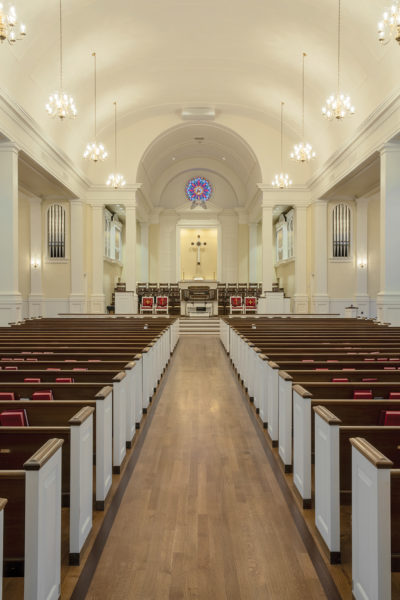
Therefore, with an enclosed portion of the Great, and suitable treatment of the Swell, we are free to consider a different way to approach the third manual division. This Solo division is loaded with tone colors at both higher and lower volume levels than the Great or Swell, so that it can be a material contributor on the pianissimo and fortissimo ends of a seamless crescendo/diminuendo. When approached with this idea, organist Scott Montgomery embraced this vision—this next logical step in the evolution of the Buzard sound and contemporary American organbuilding. Because the enclosed Great and the Swell can move everywhere independently, Scott began to dream and consider the manifold ways in which such a tonal scheme could be used. Accompanying receives the first consideration of importance, because the rich choral program under Dr. Gundersen’s direction regularly performs literature from literally every tradition. The organ can accompany the entire body of choral literature, and it can support hymnody and musically render just about any piece ever written for the organ. This is our goal. You can accompany Stanford and then play Vierne successfully; you can play Sweelinck for the opening voluntary and Sumsion for the closing voluntary, each with the effects the composer intended. And, because the instrument speaks clearly to the listeners in the nave—even though installed in off-axis chambers—the entire organ has an uncanny single voice, no matter how soft or loud it is registered.
In addition to exercising our evolving tonal style, tonal director Brian Davis and production director and chief engineer Charles Eames overcame what had seemed an impossible off-axis installation situation. Special scaling and voicing techniques, the addition of reflective panels above the pipes in the chambers, siting the divisions strategically for their best projection, utilizing slightly higher wind pressures, and other techniques—and the tremendous improvement in the church’s acoustics—gave the organ the best chance of success.
Scott Montgomery confessed his fear to me that, because of these severe physical limitations, this would be “the one organ of ours which we wouldn’t want to show to people.” But when he heard the organ’s first sounds in the church’s vastly improved acoustics, and as the entire organ came to life, he knew this would be a very special and important organ in the American lexicon. We rise to challenges and consider them opportunities to learn and improve. We’d love for you to visit this organ! Just call ahead!
John-Paul Buzard is founder, president, and artistic director of Buzard Pipe Organ Builders. He is a certified master organbuilder with the American Institute of Organbuilders, a member of the Associated Pipe Organ Builders of America, and a member of the Worshipful Company of Musicians of the City of London.
From the Tonal Director
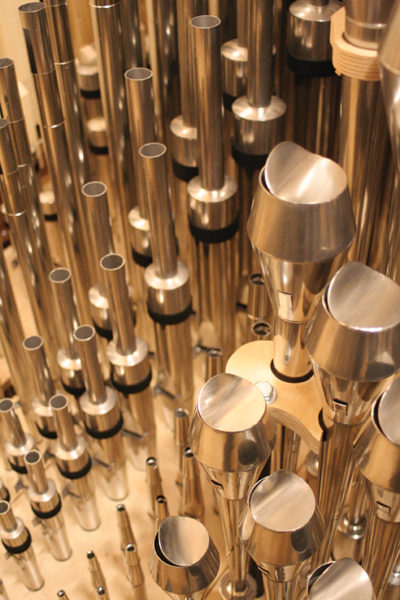
Before I dive into talking about the instrument at Central United Methodist Church, I feel it is important to clarify where I personally see myself in the organ world today and how that affects Buzard Pipe Organ Builders. You see, I am a product of the neo-Baroque era that transpired back when God was a little boy! I am proud to say that I was able to learn organbuilding during a time in which I feel the best work of that era was being done. (Regals are still my favorite organ sound!) It is of utmost importance to me that an organ of at least two manuals have two well-developed and contrasting principal choruses and that the stops contained therein blend with one another to form new sounds when they are combined!
Times change as do styles of organbuilding. To deny such has been the downfall of some otherwise good organbuilders. George Santayana was one of the people who mused that those who cannot remember the past are doomed to repeat it. In looking back at organbuilding history I cannot help but see a pattern of us throwing out the baby with the bathwater. Rather than letting the stylistic pendulum dictate what we can and can’t use in a “modern” organ, why not keep the best of past styles and incorporate them into something new? Pipe organs are increasingly expensive in a time when fewer funds are being put aside for music. Making less be more useful is a must. But how do we get past our own inhibitions and stubbornness? We have a rich tradition in organbuilding, but tradition for tradition’s sake—at the expense of innovation—is a dangerous course no matter what style is currently all the rage. If our passion for this instrument is to remain relevant at all in modern society, our instruments must be able to musically play an ever-greater variety of music, and our organists must be able to make music people can relate to, as well as teach us about the past! That is quite a challenge.
Central United Methodist’s instrument is a direct result of Buzard Pipe Organ Builders’ developing style with the concepts mentioned before, as well as others, always in the back of my mind. Our company style is founded upon the instrument being able to play a church service and accompany a choir first and foremost. This has served us well but produced instruments that were challenged to play traditional polyphonic music, since the mixtures in the Swell were lower-pitched than the Great. This grated on my training and led me to challenge my dad’s expression that you can’t have your cake and eat it too. Why not? Just think outside of the box! Don’t throw the box away, but realize it for what it is.
The Buzard divided Swell Mixture is the direct result of this way of thinking. Yes, two Swell mixtures, even in this decidedly more Romantic phase of organbuilding. One lower-pitched mixture can accompany choral anthems without being too strident. The higher mixture will fill out the lower one for full-Swell effects with the reed battery, or it can be used to echo the Great in a more traditional function. Sorry, Dad, I can have my cake and eat it too!
This two-mixture concept is very important, but it is only one part of our strategy to make smaller instruments more versatile. A partially enclosed Great that contains not only the softer Great stops but also a chorus of reeds is a critical component. Suddenly, you have in a two-manual organ the ability to register choruses in many different ways: The Swell can echo the Great principal chorus in a Bach prelude; the Swell can be used as the forte division against the Great by the use of the expression box in the Great or through simple registration; choruses within choruses are easily obtainable; three or four distinct dynamic levels can be easily had, simply by jumping from manual to manual with registration changes in between—or, more importantly, a seamless crescendo can easily be created. Solo colors abound on both manuals with abundant reed and flue colors.
But this is only a two-manual concept. Where does this leave us in a three-manual concept? I dare to say it leaves us in a position to say that the Choir organ is dead! A properly oriented two-manual instrument can do everything that a three- or even four-manual organ can do—without the expensive duplication of stops in other divisions. This leaves the organbuilder free to explore stops with colors that would otherwise be found only in much larger instruments. Add a third keyboard and stops that you might have on a four-manual or larger instrument and suddenly you have exponentially increased the potential for registrational variety!
How well does this work? I have been amazed already at the possibilities of the two manuals initially installed in this organ under the capable hands of the talented Scott Montgomery. Join us this summer to see how the organ transforms into a new and even more useful worship tool when we add the Solo to Central Methodist’s new Buzard organ!
Brian K. Davis
From the Organist
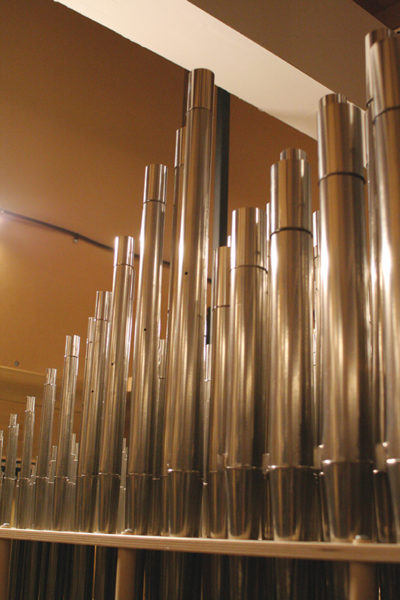
Life is full of rarities. Two years ago, I received a phone call asking to visit and interview for the position as associate director of music and organist for Central United Methodist in Fayetteville, Arkansas. I wasn’t actively looking for a new position at that time, but the temptation was too good to pass up. Central was embarking on a massive project to improve its music tradition, including building a new music suite and renovating the sanctuary, and a donation had been made for a new pipe organ. I began dreaming of what type of organ to choose even before accepting the position. Being a concert organist, I have heard and played a full spectrum of instruments. Who to choose to build the instrument, and why?
It is rare to have an amazing music school in your own backyard. Growing up in central Illinois, I had the influences of the University of Illinois, where I attended performances by Michael Farris and his students. I would hide in the balcony of the hall during summer music camp listening to the large Casavant organ in awe of its impressive sound. I would even sneak in to play the organ until the secretary would kick me out for not being a student!
It is also rare for a well-respected organ company to reside in your hometown. I remember my first organ crawl as a twelve-year-old, hearing the then new instrument (Opus 7) built by John-Paul Buzard at the Chapel of St. John the Divine in Champaign. It is an instrument of beauty with its dramatic floating case and warm and lush sounds. This instrument, along with a few others in town, continued to shape my love for the organ throughout my high school and college years. The Buzard sound was what I became familiar with and expected to hear in organbuilding. While Central UMC auditioned many builders, I always knew I had to push for a Buzard organ.
Opus 46 is a longtime want and dream. Having an organ built before your eyes and watching the installation is a once- in-a-lifetime event. The facades are stunning and crown the renovated chancel. This instrument is extremely flexible and expressive with only the Great principal chorus and Pedal unenclosed. The full reed battery whispers when the expression box is closed but commands attention with the box open. The principal choruses are bright, clear, and articulate for contrapuntal music and for leading hymns. The strings are full-bodied and ethereal. The flutes are colorful with just the right amount of breath and harmonic development. Every flute, string, and reed stop is completely different from the others, full of character, yet blending together in a harmonious sound. Full organ is thrilling, yet one could spend hours playing the strings or the small Gedeckt Flute with its gentle tremulant with complete contentment.
The organ has proven itself in worship with inspirational leadership as well as playing every genre of music successfully without compromise. This instrument is one of kind in northwest Arkansas, and I’m proud to bring this instrument to the area to inspire everyone who encounters its visual and aural beauty.
Scott Montgomery
March 2019 TAO Feature Article
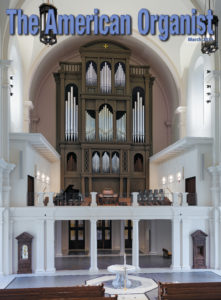 Holy Name of Jesus Cathedral
Holy Name of Jesus Cathedral
Raleigh, North Carolina
Fisk Opus 147
View an enlarged cover
View the Stop List
by Gregory Bover

In the early spring of 2014, C.B. Fisk received a request for a proposal from the Roman Catholic Diocese of Raleigh, North Carolina, asking us to imagine an organ for the new Holy Name of Jesus Cathedral, then in the middle stages of design. The planned building was enormous: 43,000 square feet of floor space with seating for 2,000 people under a barrel-vault ceiling nearly 80 feet high. Although we have built more organs in North Carolina than in any other state except Massachusetts, this would be our first new instrument in a Catholic church in 50 years. Our enthusiastic response included two proposals: the smallest organ we felt appropriate, at three manuals and 51 stops, and a much larger four-manual instrument of 72 stops. A letter of intent was signed several months later based on the smaller specification with options allowing for additions to be made at a later date. The agreement allowed us to begin design, and gave the diocese a guaranteed spot on our docket. A full contract was signed the following year with a specification that eventually expanded to 62 stops.
Our experience on almost every project we undertake, and especially those of similar grand scale, is that the best results are obtained by a three-cornered collaboration between the architect, the acoustician, and the organbuilder. We were fortunate to have been contracted early enough in the design of the building to allow us to work with architects O’Brien & Keane and acoustician Dana Kirkegaard toward a successful synthesis, not only for the organ but for music making of all types in the west end gallery. Our proposal advocated for the inclusion of a massive wall of filled concrete block behind the organ to efficiently project the sound of the organ and the choir into the vast nave, and for the diocese to involve Mr. Kirkegaard in many other design decisions, including an HVAC system that could maintain the entire organ at consistent tuning temperature while operating very quietly. He also proposed angled lower side walls in the gallery, creating a horn shape in which the choir risers might be arrayed, with reflective projecting soffits at their upper edges, allowing choristers to hear themselves and one another—so important for cohesive ensemble. In addition, the walls and ceiling of the nave received two layers of gypsum and cement board bonded together. Closer to the organ and choir, where early reflection is essential, the walls are three layers thick.
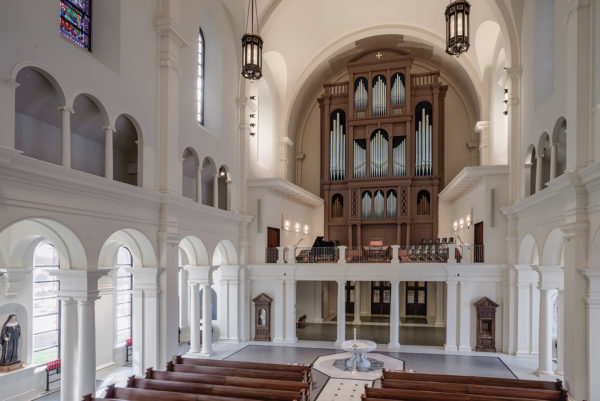 With these architectural/acoustical elements in place, the Fisk design team could begin the crucial layout of the divisions within the instrument. The inevitable acoustical-focusing properties of the barrel-vault ceiling all but required that the Great division’s powerful choruses should be at the top of the organ to dramatically project their speech unimpeded down the lengthy nave. The enclosed Choir division, with its primary role of choral accompaniment, was situated at the lowest level of the case, where its voices could take advantage of the reflecting walls and soffits that also surround the choristers. This division is voiced gently enough not to overwhelm, yet focused enough to be pleasantly present when heard from the nave floor. The Swell division, also under expression, is at mid-height between the other two manual divisions, speaking into the widest part of the room with no close-in support from walls or vaulting. This placement resulted in a more diffuse and ethereal sound, an appropriate contrast to the more unequivocal impact of the other manual divisions. The Pedal division, which includes three stops at 32′ pitch, somewhat less sensitive to placement at these low pitches, is arranged on several levels of the organ. It stands in close proximity to the massive back wall so that it will efficiently rumble into the room. The eight lowest pipes of the immense wooden Great Bass 32′ form the side walls of the organ case.
With these architectural/acoustical elements in place, the Fisk design team could begin the crucial layout of the divisions within the instrument. The inevitable acoustical-focusing properties of the barrel-vault ceiling all but required that the Great division’s powerful choruses should be at the top of the organ to dramatically project their speech unimpeded down the lengthy nave. The enclosed Choir division, with its primary role of choral accompaniment, was situated at the lowest level of the case, where its voices could take advantage of the reflecting walls and soffits that also surround the choristers. This division is voiced gently enough not to overwhelm, yet focused enough to be pleasantly present when heard from the nave floor. The Swell division, also under expression, is at mid-height between the other two manual divisions, speaking into the widest part of the room with no close-in support from walls or vaulting. This placement resulted in a more diffuse and ethereal sound, an appropriate contrast to the more unequivocal impact of the other manual divisions. The Pedal division, which includes three stops at 32′ pitch, somewhat less sensitive to placement at these low pitches, is arranged on several levels of the organ. It stands in close proximity to the massive back wall so that it will efficiently rumble into the room. The eight lowest pipes of the immense wooden Great Bass 32′ form the side walls of the organ case.
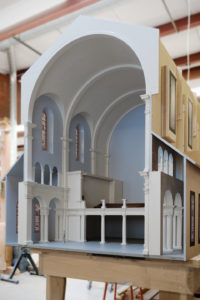
The location of the divisions within the case informs the visual design of the outside. The three-tiered composition honestly conveys the internal musical hierarchies to both casual and erudite viewers. As is our long-established practice, we built a 1:16 scale model of the west end of the cathedral-to-be, itself the largest we had ever created. A model at this scale allows visual designer Charles Nazarian to work out the pipe arrays, casework shaping, and decorative detail. It fosters collaboration between the organbuilders and all the partners in the project—architects, client representatives, and musicians—so that the result is an organ that looks “as if it had always been there”—the high bar set by our founder, Charles Fisk.
The design that emerged from a long gestation and countless experiments emphasizes the beauty of the front pipes in forms reminiscent of classical Italian organs, showing their true speaking lengths in dramatic contrast to the dark background inside the organ. A key feature of this style is the visual connection of the pipe mouths in ribbon-like patterns across the instrument’s facade. The major casework elements, such as column plinths, capitals, arches with keystones, balustrades, and a grand semicircular pediment at the top with a central cross, all speak in the language of the Italian Renaissance, but without the extreme level of decoration in the original examples. Like O’Brien & Keane’s building, the organ’s outward design is an exercise in restraint and noble simplicity.
The central purpose of the final specification and tonal design was to create an organ devoted to accompanying the 21st-century Roman Catholic liturgy. Having the resources for encouraging congregational song, supporting a wide variety of choral repertoire, and serving as an inspirational vehicle for improvisation, were all paramount. Authentic performance of solo organ repertoire, although a lesser priority, was always present in our thinking.

The stoplist represents an exploration of organ sounds beyond the stereotypical. The complex relationships of the eclectic collection of voices, as opposed to those of a single national tonal style, require extraordinary thought and care in voicing and balancing. The Great, based on the Double Diapason 16′ in the upper facade, is home to five 8′ flue foundations: Open Diapasons I and II in the English style, a Gamba and Harmonic Flute based on models from Parisian Cavaillé-Coll, and a Double Flute after those encountered in the work of the 19th-century German master Friedrich Ladegast. Two heroic solo voices are also found in the Great: the Corneta Magna X, which takes as its antecedent the stop of the same name in Jordi Bosch’s 1765 organ at Santanyí, Majorca (details generously provided by Gerhard Grenzing, who restored this amazing instrument); and the Pontifical Trumpet, a high-pressure reed after Henry Willis examples. Their disparate origins and strong individual characters notwithstanding, the foundations, upperwork, and reeds throughout the organ were carefully chosen and voiced to be used in combinations limited only by the imagination of the player.
Both the Choir and Swell divisions are under expression, and both, like the Great, include a multiplicity of 8′ flue foundations. Together they also feature no fewer than five undulant pairs. The impressive dynamic range of Opus 147 extends from the quietest stops in the Swell division, nearly inaudible with the shades closed, to the cast-iron full-organ sonority with manuals coupled and full, fiery, yet rounded reed choruses engaged. Some firsts for Fisk include the wooden harmonic Orchestral Flute 8′ in the Choir, as well as the Contra Gamba 16′ with Haskell basses and the Dulciana 8′ and Dulciana Celeste in the Swell. The Pedal division boasts three 32s: the mp Sub Principal with Haskell basses, the f full-length Great Bass, and the ff Contra Trombone.
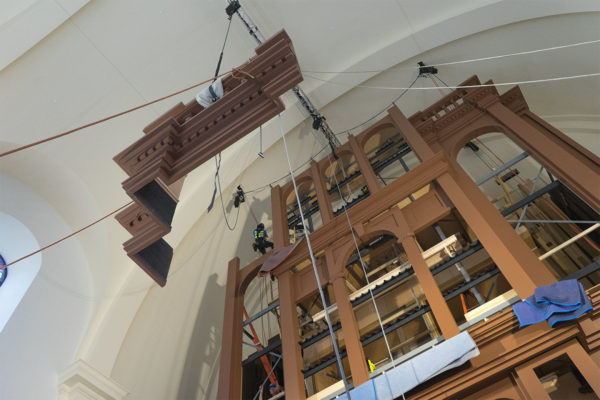
The decision to detach the console from the main organ, while allowing the organist and choir to communicate more directly, is not one to be taken lightly in a mechanical-action organ. Adding 12 feet to the length of tracker runs already approaching 50 feet up to the highest windchests could compromise the sensitivity of the keyboards were it not for the experience we have at engineering such lengthy actions. The use of ultralight, non-stretching carbon fiber rod as tracker material and careful attention to detail at each turning of the connections has produced a light and responsive action. A Kowalyshyn Servopneumatic lever, developed at C.B. Fisk and similar to a Barker lever, is engaged when any division is coupled to the Great or when the Octaves graves coupler is drawn; however, the Great itself is always played mechanically. The stop action is electric solenoid with a combination action and sequencer by Solid State Organ Systems. The 58-foot-tall, 22½-ton organ was delivered to Raleigh in February 2018 in three semitrailer moving vans.
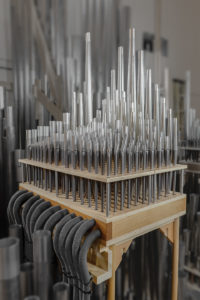
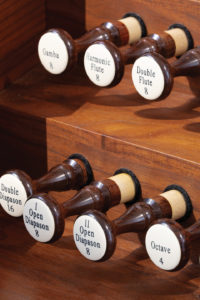
The work of architect James O’Brien and acoustician Dana Kirkegaard resulted in a cathedral of visual and aural beauty. Our installation and finish-voicing crews spent more than ten months ensuring that Opus 147 perfectly complements that beauty. The support of the donors, staff, and governance of the Diocese of Raleigh has been indispensable to the pursuit of our art. The men and women of C.B. Fisk commend this instrument to the present and future congregations of Holy Name of Jesus Cathedral.
Gregory Bover is project manager emeritus for C.B. Fisk Inc.
National Endowment for the Arts
AMERICAN GUILD OF ORGANISTS
AWARDED $20,000 GRANT FROM THE
NATIONAL ENDOWMENT FOR THE ARTS
NEA Funding Will Support Educational Programs in 2019
NEW YORK CITY — The American Guild of Organists (AGO) has been awarded a $20,000 Art Works grant by the National Endowment for the Arts (NEA) to support educational programs and career development for organists and choral conductors in 2019. The Guild has received regular support from the NEA since 2005 totaling $200,000.
“It is an honor for the Guild to be recognized again by the NEA, the most prestigious independent federal agency in the United States responsible for funding and promoting artistic excellence, creativity, and innovation,” stated AGO Executive Director James Thomashower. “This Art Works grant covers the full breadth of the AGO’s educational activities for current and prospective members as well as our programs of outreach to the public.”
The AGO promotes lifelong learning opportunities ranging from Pipe Organ Encounters (POEs) for youth and adults to a professional certification program for organists and choral conductors. This summer, more than 100 participants are expected to attend POEs, which include a POE Advanced and a POE Technical, while more than 100 people will improve their skills and opportunities for employment through the Professional Certification Program. Thousands of people will benefit from educational workshops and extraordinary performances of organ and choral music at seven AGO Regional Conventions held from coast to coast this summer.
Art Works is the NEA’s principal grant making program. In February, the Arts Endowment stated that it received 1,605 Art Works applications for this round of grant making, and will award 972 grants in this category totaling $27 million. “The arts enhance our communities and our lives, and we look forward to seeing these projects take place throughout the country, giving Americans opportunities to learn, to create, to heal, and to celebrate,” said Mary Anne Carter, acting chairman of the National Endowment for the Arts.
“The NEA’s funding sends a positive, uplifting message to the entire organ community: our instrument and its music are vitally important to the American people,” Thomashower added. “NEA grants such as this represent our tax dollars at work. The award validates the AGO’s ongoing efforts to ensure that music for the organ is appreciated by the widest audience possible.”
Established by Congress in 1965, the National Endowment for the Arts is the independent federal agency whose funding and support gives Americans the opportunity to participate in the arts, exercise their imaginations, and develop their creative capacities. Through partnerships with state arts agencies, local leaders, other federal agencies, and the philanthropic sector, the NEA supports arts learning, affirms and celebrates America’s rich and diverse cultural heritage, and extends its work to promote equal access to the arts in every community across America.
For a complete listing of projects recommended for Art Works grant support, visit www.arts.gov.


